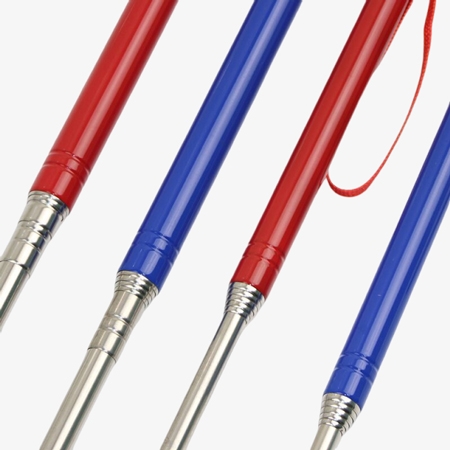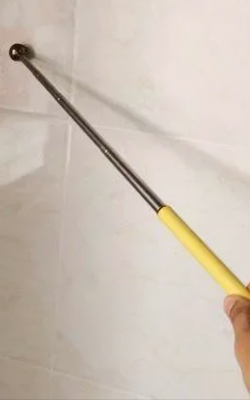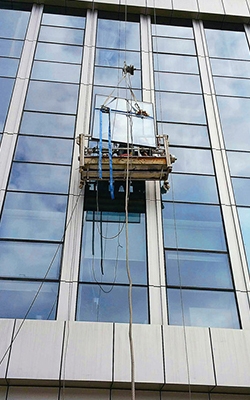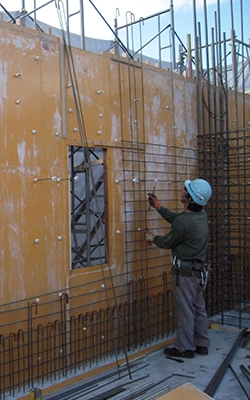The telescopic stick sound inspection hammer is a non-destructive testing tool used to detect internal defects such as voids, cracks, or delaminations in materials through auditory feedback. It features a telescopic handle that allows the user to extend the hammer’s reach, making it convenient for inspecting hard-to-access or elevated areas. The tool is commonly used in construction, bridge maintenance, and concrete structure inspection.

The pole body can be extended
- The sound inspection hammer is a telescopic design. The pole body of the telescopic stick sound inspection hammer can be freely extended and retracted, with flexible operation to adapt to different working environments.
- The durable hammer head of the telescopic stick sound inspection hammer is made of sturdy metal material, and it has a long service life.
- The sound is clear when struck, which helps to determine the internal state of the material.

Aluminum alloy material, sturdy and durable
- The structure of the telescopic stick sound inspection hammer is lightweight, making it easy to carry and operate on site for extended periods of time.
- The handle of the telescopic stick sound inspection hammer is designed to be comfortable, securely held, and resistant to slipping and shock.
- It is suitable for industries such as building inspection, municipal engineering, rail transit, tunnels, bridges, etc.
Applications
The SISCO sound detection hammer is a specialized tool widely used in non-destructive testing (NDT) to evaluate the structural integrity of materials by acoustic feedback. It is commonly applied in the inspection of concrete, stone, ceramics, and other solid materials for detecting internal cracks, voids, delaminations, or loose parts. The hammer produces a characteristic sound upon impact, which is analyzed by experienced operators to assess material conditions.

Floor or Tile Inspection

Tunnel Inspection

High Places Areas

Construction Inspection
| Model | SISCO-SH-98cm |
| Hammer Head Material | Stainless steel |
| Spherical Diameter | 19mm |
| Weight | 0.8kg |
| Stretching Length | 98cm |
| Color | Red, blue |
Q1: What is a telescopic stick sound inspection hammer used for?
A1: The telescopic stick sound inspection hammer is primarily used to detect internal voids, cracks, delamination, or structural defects in materials such as concrete, tiles, ceramics, and composites by tapping and listening for changes in sound.
Q2: How does a sound inspection hammer work?
A2: The user gently taps the surface with the hammer. A clear ringing sound usually indicates a solid structure, while a dull or hollow sound suggests a defect or void underneath.
Q3: What are the advantages of the telescopic design?
A3: The telescopic hammer can be used in various environments, including buildings, bridges, tunnels, and pavements.
- Adjustable length for accessing hard-to-reach areas (e.g., ceilings, bridge undersides).
- Compact storage and portability.
- Safer operation from the ground without ladders or scaffolding.
Tips: How to use the telescopic stick sound inspection hammer?
- Confirm the telescopic locking structure: Before use, check whether the telescopic rod has a reliable locking mechanism to prevent the sliding of the rod body during the tapping process from affecting the detection accuracy or causing injury.
- Adjust the force according to the target material: When striking different materials (such as concrete, steel structures, ceramic tiles, etc.), adjust the striking force to avoid damaging the surface of the tested object.
- Maintain vertical tapping: When tapping the surface, try to maintain a vertical angle as much as possible, which can help generate clear echoes and facilitate the judgment of whether the internal structure is hollow, loose, or cracked.
- Pay attention to the auditory environment: Operate in a quiet environment to avoid background noise interfering with listening judgment. If necessary, wear a listening aid.
- Regularly check the condition of the hammer head: Loose, worn, or broken hammer heads can affect the test results, and it is recommended to replace or tighten them regularly.
Thank you for buying industrial test and measurement equipment on SISCO.com, all products sold by SISCO and the partner cover a 12 months warranty, effective from the date of receiving the products.
What is covered?
SISCO is responsible for providing free spare parts, and free technical support to assist the customer to repair the defective products until the problem is solved.
What is not covered?
- Product purchased from anyone other than a SISCO store or a SISCO authorized reseller.
- Expendable parts.
- Routine cleaning or normal cosmetic and mechanical wear.
- Damage from misuse, abuse or neglect.
- Damage from use of parts other than SISCO approved.
- Damage from use outside the product’s usage or storage parameters.
- Damage from use of parts not sold by SISCO.
- Damage from modification or incorporation into other products.
- Damage from repair or replacement of warranted parts by a service provider other than a SISCO authorized service provider.
- Damage caused by the application environment not meeting the product usage requirements and the failure to perform preventive maintenance.

